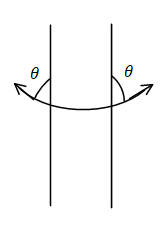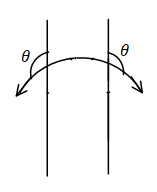
Which of the following is not true about angle of contact?
A) The value of angle of contact for pure water and glass is zero.
B) Angle of contact increases with increase in temperature of liquid.
C) If the angle of contact of a liquid and a solid surface is less than ${90^ \circ }$, then the liquid spreads on the surface of solid.
D) Angle of contact doesn’t depend upon the inclination of the solid surface to the liquid surface.
Answer
219k+ views
Hint: The angle of contact is actually the angle between the meniscus and the containing walls of a column of liquid measured from the vertical wall below the surface of the liquid to the position of the tangent to the meniscus at its point of contact with the wall. Angle of contact depends on the nature of liquid and solid, medium in which angle of contact is being made and purity of liquids and solids.
Complete solution:
The problem is asking for the correct statements regarding the angle of contact. So we will consider each statement and then find which of the options is correct.
Let us consider the option A.
For pure water and pure glass, the angle of contact is$0^\circ $. For ordinary water and glass, it lies between \[8^\circ \] and\[18^\circ \]. Hence this statement is true.
Consider option B.
With the increase in temperature, the surface tension of liquid decreases. Due to this the liquid surface on the solid surface becomes more flat so the angle of contact of a liquid increases with the increase in temperature. So the statement in option B is true.
Consider option C.
If the angle of contact of a liquid and a solid surface is less than ${90^ \circ }$, then the liquid spreads on the surface of solid, this statement is also true because for contact angle less than ${90^ \circ }$ the difference in the surface tensions of air-solid interface and liquid-solid interface is less than the air-liquid interface.
The diagram for the angle of contact for less than ${90^ \circ }$.

The diagram for the angle of contact more than ${90^ \circ }$.

Consider option D.
Angle of contact doesn’t depend upon the inclination of the solid surface to the liquid surface. Angle of contact actually depends on the inclination of the solid surface so this statement for option D is not true.
The correct answer for this problem is option D.
Note: Keep in mind that the shape of meniscus is decided by the angle of contact which depends on the surface tension. Glass and water always make a concave surface & glass and mercury always makes a convex surface.
Complete solution:
The problem is asking for the correct statements regarding the angle of contact. So we will consider each statement and then find which of the options is correct.
Let us consider the option A.
For pure water and pure glass, the angle of contact is$0^\circ $. For ordinary water and glass, it lies between \[8^\circ \] and\[18^\circ \]. Hence this statement is true.
Consider option B.
With the increase in temperature, the surface tension of liquid decreases. Due to this the liquid surface on the solid surface becomes more flat so the angle of contact of a liquid increases with the increase in temperature. So the statement in option B is true.
Consider option C.
If the angle of contact of a liquid and a solid surface is less than ${90^ \circ }$, then the liquid spreads on the surface of solid, this statement is also true because for contact angle less than ${90^ \circ }$ the difference in the surface tensions of air-solid interface and liquid-solid interface is less than the air-liquid interface.
The diagram for the angle of contact for less than ${90^ \circ }$.

The diagram for the angle of contact more than ${90^ \circ }$.

Consider option D.
Angle of contact doesn’t depend upon the inclination of the solid surface to the liquid surface. Angle of contact actually depends on the inclination of the solid surface so this statement for option D is not true.
The correct answer for this problem is option D.
Note: Keep in mind that the shape of meniscus is decided by the angle of contact which depends on the surface tension. Glass and water always make a concave surface & glass and mercury always makes a convex surface.
Recently Updated Pages
Two discs which are rotating about their respective class 11 physics JEE_Main

A ladder rests against a frictionless vertical wall class 11 physics JEE_Main

Two simple pendulums of lengths 1 m and 16 m respectively class 11 physics JEE_Main

The slopes of isothermal and adiabatic curves are related class 11 physics JEE_Main

A trolly falling freely on an inclined plane as shown class 11 physics JEE_Main

The masses M1 and M2M2 M1 are released from rest Using class 11 physics JEE_Main

Trending doubts
JEE Main 2026: Application Form Open, Exam Dates, Syllabus, Eligibility & Question Papers

Understanding Uniform Acceleration in Physics

Derivation of Equation of Trajectory Explained for Students

Hybridisation in Chemistry – Concept, Types & Applications

Understanding the Angle of Deviation in a Prism

Understanding Collisions: Types and Examples for Students

Other Pages
JEE Advanced Marks vs Ranks 2025: Understanding Category-wise Qualifying Marks and Previous Year Cut-offs

Units And Measurements Class 11 Physics Chapter 1 CBSE Notes - 2025-26

NCERT Solutions For Class 11 Physics Chapter 8 Mechanical Properties Of Solids

Motion in a Straight Line Class 11 Physics Chapter 2 CBSE Notes - 2025-26

NCERT Solutions for Class 11 Physics Chapter 7 Gravitation 2025-26

Understanding Atomic Structure for Beginners




